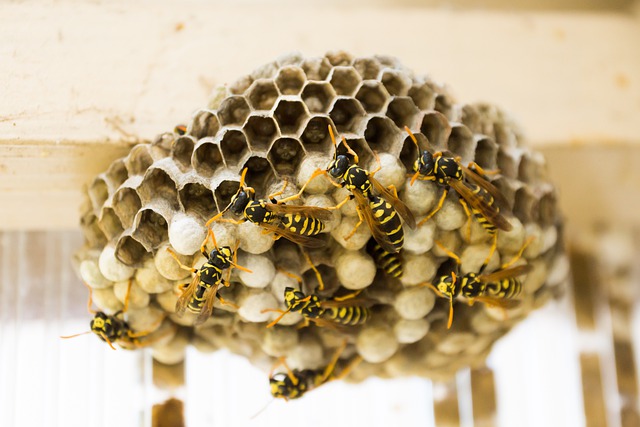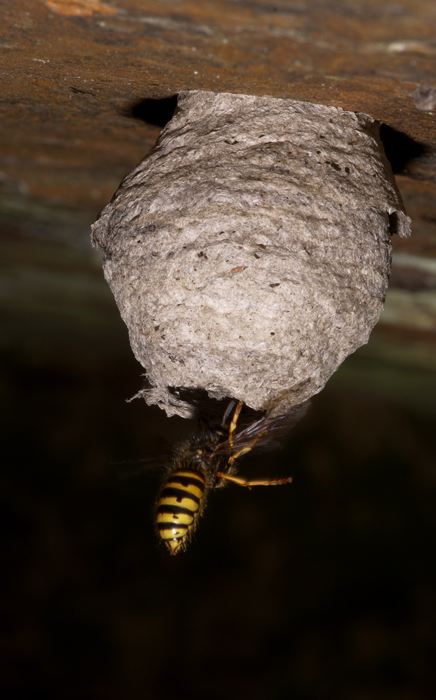
Hornets and wasps are annoying pests that love to fly around while you are eating outside. Their stings are painful, and dangerous if you’re allergic, so it could be a good idea to get rid of them.
The best way to get rid of hornets and wasps is to find their nest and use an insecticidal spray on it. Use extreme caution when attempting this because they could swarm you. A natural method to kill hornets and wasps is with a homemade bait trap. After getting rid of them, you need to take measures to stop them from returning. It’s also good to identify what type of hornet or wasp you’re dealing with.
With some effort, you can get rid of hornets and wasps. Study the rest of this article for more details on eliminating these flying menaces.
You might also be interested in reading these two related articles “How To Get Rid Of Cicada Killer Wasp (Ground Digger Wasp)” and “How To Get Rid Of Carpenter Bees“.
Getting Rid Of Hornets and Wasps With Insecticidal Spray
While hornets and wasps are beneficial to the environment, they are annoying, can be aggressive and cause pain if they sting you. It’s best to get rid of hornets and wasps if you frequently find yourself coming into contact with them.
Be aware that hornets and wasps don’t want to be disturbed and will defend their nests. Therefore, you risk serious injury if you try to get rid of them yourself. Especially for large infestations, it’s best to call in professionals to help eliminate hornets and wasps.
Staying Safe While Getting Rid Of Hornets and Wasps

You need to remember the risks of eliminating hornets and wasps. Fortunately, there are measures you can take to keep yourself safe during this process, such as:
- Have an escape route. Hornets or wasps could swarm you while you’re spraying them.
- Hornet and wasp sprays are oil-based and stick to everything. Try not to hit anything you don’t have to and wash off the residue after the insects are gone.
- Never stand directly under the nest because angry hornets or wasps could come charging out and attack you.
- Don’t stand on ladders. You could fall if hornets or wasps swarm you and get seriously hurt.
Eliminating hornets and wasps is not worth hurting yourself over. If you don’t feel comfortable attempting to get rid of them, seek professional help.
Step 1: Find The Nest

Hornets and wasps live in colonies with up to 1000 individuals. If they bother you at your home, there is probably a nest nearby. Observe the hornets or wasps and see if they lead you to their nest.
Hornet nests look smooth, are tear-drop shaped and gray, with a single entrance hole at the bottom. On the other hand, wasp nests have swirly gray textured exteriors with multiple entrances. Both types of nests could be under building eaves or in trees.
Step 2: Spray Insecticide On The Nest
There are many hornet and wasp sprays available at home improvement stores or online. Choose one with a nozzle for spraying long distances.
The night is the best time to spray because the hornets or wasps are less active. Use personal protective equipment like gloves, goggles and a face mask to prevent exposing yourself to insecticide.
Check on the nest the next day. If you see more active hornets and wasps, spray the nest again. Continue checking and spraying the nest until all the insects are dead.
Step 3: Remove The Nest
Use a broom or pole to knock the nest down. Knock it directly into a garbage bag if possible.
Wear gloves to prevent getting any insecticide on your skin. Seal the garbage bag to stop other insects or animals from investigating the nest.
How To Get Rid Of Hornets and Wasps Naturally
Insecticidal hornet and wasp spray could kill insects or animals you don’t want to kill. It could also irritate your eyes or skin, and can be dangerous if you’re exposed to too much of it. For these reasons, you might try to get rid of hornets and wasps in a more environmentally friendly way.
Make A Two-Liter Bottle Hornet and Wasp Trap
The wasp and hornet traps available at stores are effective, but you can also make your own. The steps to make your own hornet and wasp trap are:
- Cut the top third off of an empty two-liter bottle.
- Place bait in the bottom of the bottle. You can use rotting meat, overripe fruit, canned cat food, juice or soda to attract hornets and wasps.
- With the cap off, place the top of the bottle inside the bottom of the bottle, so it looks like a funnel pointing towards the bait.
- Seal the top edge between the two pieces of the bottle with tape.
- Put the trap near the hornet nest. Alternatively, hang the bottle away from your home and outdoor living areas.
- Once the trap is full, seal it in a bag and put it in the freezer.
- The next day, put the dead insects into the trash or compost.
This trap works because the hornets or wasps are lured into the bottle by the bait. Then, when they try to fly out they always aim for the highest point. Unfortunately for them, the opening is below the highest point and they get trapped in the bottle.
Remember that this trap attracts hornets and wasps, so don’t place it near your living areas. Additionally, some hornets or wasps could escape.
Above all else, use extreme caution when you collect the trap.
How To Get Rid Of Hornets and Wasps With Vinegar
Amazingly, there’s a lot of bad advice about using vinegar to get rid of hornets or wasps on the internet. Vinegar attracts hornets and wasps, but it doesn’t repel them. Therefore, the best way to get rid of hornets and wasps with vinegar is to use it as bait in your traps.
Vinegar smells like rotting fruit, so it attracts hornets and wasps. Add some sugar and dish soap to the vinegar to make a deadly combination. The sugar has more smells that attract hornets and wasps, while soap makes it easier for them to drown if they land on the bait.
Spraying vinegar onto a hornet or wasp nest could kill them, but it would take longer than an insecticidal spray. Consequently, it’s more likely you could be swarmed and attacked while spraying the nest. In the end, it’s better to use an insecticidal spray or call in a pest control expert than to use vinegar as a hornet and wasp spray.
How To Get Rid Of Wasps and Hornets When You Can’t Find the Nest
A common situation for many people is to have hornets or wasps flying near their picnic or cookout, with no nest in sight. To get rid of hornets or wasps flying around, place a trap as far away as you can, but within sight.
Many of the hornets and wasps that would be attracted by your activities will find the trap instead. At the very least, this method will reduce the number of hornets or wasps that come close to you.
How To Repel Hornets and Wasps
If you successfully get rid of hornets or wasps, the next step is to keep them from returning. Fortunately, there are many measures you can take to repel hornets and wasps, including:
Remove Food Sources
Hornets and wasps are attracted by sugary or protein-rich foods. Steps you can take to remove hornet and wasp food sources include:
- Clean up after meals.
- Clean up fallen fruit during harvest season.
- Place hummingbird feeders away from your house and living areas.
- Use a tight-fitting lid on garbage cans.
- Use a sealed compost bin or cover compost piles.
Seal Your Home
Hornets and wasps can fit through tiny holes to enter your home. Ensure they can’t enter your home by taking sealing measures, including:
- Use screens on windows and doors.
- Repair screens if you already have them.
- Install door sweeps under doors and weather stripping around windows and doors.
- Patch cracks or holes in your foundation, siding and vents.
Maintain Your Landscaping
A messy yard makes a better environment for hornets and wasps. Some yard maintenance you can do includes:
- Trim grasses, hedges and shrubs.
- Don’t plant sweet-smelling flowers near living areas.
- Remove dead or hollowed trees where hornets and wasps could build a nest.
You can also plant plants that help repel hornets and wasps, such as:
- Pennyroyal
- Marigold
- Wormwood
- Mint
- Basil
- Geranium
Watch For New Nests
Stay vigilant in areas that have hosted nests before or you think could be good spots. Getting rid of a new nest is easier than getting rid of an established one.
Pre-treat these areas with residual liquid insecticide or essential oils. Some essential oils that keep hornets and wasps away include:
- Clove
- Lemongrass
- Peppermint
- Geranium
Identifying Hornets, Wasps and Other Insects
Hornets or wasps could be one of several different insects, depending on where you are. Identifying the type of flying insect you’re dealing with helps you get rid of them more effectively and efficiently.
How To Identify Hornets
The European hornet is the only true hornet in North America, though other flying insects might be called hornets. Humans introduced European hornets to the U.S. in the 1850s. The species is concentrated in the south-eastern states but lives throughout the country.
These flying insects have “C” shaped, deeply indented eyes, reddish-brown wings and a yellow abdomen with brown stripes. European hornets are about one inch long, with the queen reaching 1.4 inches. They are slightly hairy but not as hairy as bees.
European hornets build their nests inside trees, on tree branches, in attics, under eaves or in other dark, protected places. The nests have a gray, papery envelope. Inside the protective envelope are paper combs where the queen lays eggs.
How To Identify Wasps
There are several types of wasps in the U.S. The wasp species you might see around your home include:
- Yellow Jackets- These wasps are bright yellow and black, about a half-inch long and have smooth bodies. Their nests have a paper envelope.
- Paper Wasps- These insects are yellow and brown, grow one inch long and have thin waists. Their nests have no paper envelope.
- Mud Daubers- These wasps have a long, needle-like mid section that sets them apart from others. They live alone and don’t build nests.
- Bald-Faced Hornet- This is a wasp, despite the colloquial name. They have white and black stripes and smooth bodies. Their nests have paper envelopes.
How To Tell the Difference Between Wasps, Hornets and Bees
Bees, hornets and wasps are both helpful to the environment because they pollinate flowers. Some ways to tell bees and wasps apart are:
- Bees have a thicker body, on the other hand, wasps and hornets have a slender body.
- Bees are hairy, while wasps are smooth and hornets might have a few hairs.
- Wasps and hornets eat meat, other insects or sweets, while bees only eat pollen or sweets.
- Bees make their nests from wax, while wasps and hornets make a paper nest.
- Bees leave their stingers in your skin, while wasps and hornets don’t leave their stinger and can sting multiple times.